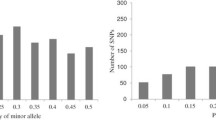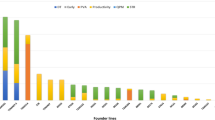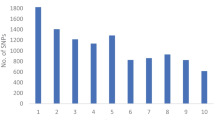Summary
The objectives of this study were (1) to investigate genetic diversity for RFLPs in a set of important maize inbreds commonly used in Italian breeding programs, (2) to compare genetic similarities between unrelated lines from the same and different heterotic groups, and (3) to examine the potential of RFLPs for assigning maize inbreds to heterotic groups. Forty inbreds were analyzed for RFLPs with two restriction enzymes (EcoRI and HindIII) and 82 DNA clones uniformly distributed over the maize genome. Seventy clone-enzyme combinations gave single-banded RFLP patterns, and 79 gave multiple-banded RFLP patterns. The average number of RFLP patterns detected per clone-enzyme combination across all inbreds was 5.8. RFLP data revealed a wide range of genetic diversity within the two heterotic groups assayed, Iowa Stiff Stalk Synthetic (BSSS) and Lancaster Sure Crop (LSC). Genetic similarity (GS) between lines was estimated from binary RFLP data according to the method of Nei and Li (1979). The mean GS for line combinations of type BSSS × LSC (0.498) was substantially smaller than for unrelated line combinations or type BSSS × BSSS (0.584) but almost as great as for un-related line combinations of type LSC × LSC (0.506). Principal coordinate and cluster analyses based on GS values resulted in the separate groupings of lines, which is consistent with known pedigree information. A comparison between both methods for multivariate analyses of RFLP data is presented.
Similar content being viewed by others
References
Anonymous (1989) Seedman's handbook, 16th edn. MBS Inc, Ames, Iowa
Beckmann JS, Soller M (1986) Restriction fragment length polymorphisms and genetic improvement of agricultural species. Euphytica 35:111–124
Bertolini M, Bosio M, Bressan M, Coppolino F, Di Fonzo N, Gentinetta E, Introzzi F, Lupotto E, Maggiore T, Perenzin M, Snidaro M, Valoti P, Verderio A, Bianchi A, Soave C, Lorenzoni C, Motto M, Salamini F (1991) Breeding activities of the maize station of Bergamo: synthetic gene pools and inbreds released in the period 1975–1989. Maydica 36:87–106
Birnboim HC, Doly J (1979) A rapid alkaline extraction procedure for screening recombinant plasmid DNA. Nucleic Acids Res 3:2303–2308
Burr B, Evola SV, Burr FA, Beckmann JS (1983) The application of restriction fragment length polymorphism to plant breeding. In: Setlow JK, Hollaender A (eds) Genetic engineering, vol. 5: Genetic engineering principles and methods. Plenum Press, New York, pp 45–59
Burr B, Burr FA, Thompson KH, Albertsen MC, Stuber CW (1988) Gene mapping with recombinant inbreds in maize. Genetics 188:519–526
Coe EH, Neuffer MG, Hoisington DA (1988) The genetics of corn. In: Sprague GF, Dudley JW (eds) Corn and corn improvement, 3rd edn. Agronomy Monograph 18, Am Soc Agron, Madison, Wis., pp 81–258
Cross JW, Adams WR (1984) Differences in the embryo specific globulins among maize germplasm synthetics. Crop Sci 23: 1160–1162
Dice LR (1945) Measures of the amount of ecologic association between species. Ecology 26:297–302
Eberhart SA, Hallauer AR, Russel WA (1972) Registration of four maize germplasm synthetics. Crop Sci 12:132
Evola SV, Burr FA, Burr B (1986) The suitability of restriction fragment length polymorphisms as genetic markers in maize. Theor Appl Genet 71:765–771
Falconer DS (1981) Introduction to quantitative genetics, 2nd edn. Longman, London
Feinberg AP, Vogelstein B (1983) A technique for radiolabelling DNA restriction fragment length polymorphisms to high specific ac tivity. Anal Biochem 132: 6–13
Godshalk EB, Lee M, Lamkey KR (1990) Relationship of restriction fragment length polymorphisms to single cross hybrid performance of maize. Theor Appl Genet 80:273–280
Goodman MM, Stuber CW (1983) Races of maize. VI. Isozyme variation among races of maize in Bolivia. Maydica 28:169–187
Gower JC (1966) Some distant properties of latent root and vector methods used in multivariate analysis. Biometrika 53:325–338
Hallauer AR, Russel WA, Smith OS (1983) Quantitative analysis of Iowa Stiff Stalk Synthetic. Stadler Symp 15:83–104
Hallauer AR, Russell WA, Lamkey KR (1988) Corn breeding. In: Sprague GF, Dudley JW (eds) Corn and corn improvement. 3rd edn. Agronomy Monograph 18, Am Soc Agron, Madison, Wis., pp 463–564
Helentjaris T (1987) A genetic linkage map for maize based on RFLPs. TIG 3:217–221
Helentjaris T, King G, Slocum M, Siedenstrang C, Wegman S (1985) Restriction fragment length polymorphisms as probes for plant diversity and their development as tools for applied plant breeding. Plant Mol Biol 5:109–118
Helentjaris T, Slocum M, Wright S, Schaefer A, Nienhuis J (1986) Construction of genetic linkage maps in maize and tomato using restriction fragment length polymorphisms. Theor Appl Genet 72:761–769
Henderson CB (1984) Maize research and breeders manual no. 10. Illinois Foundation Seeds Inc, Champaign, Ill.
Lee M, Godshalk EB, Lamkey KR, Woodman WL (1989) Association of restriction fragment length polymorphisms among maize inbreds with agronomic performance of their crosses. Crop Sci 29:1067–1071
Malecot G (1948) Les mathematiques de l'heredite. Masson et Cie, Paris
Melchinger AE, Lee M, Lamkey KR, Woodman WL (1990a) Genetic diversity for restriction fragment length polymorphisms: relation to estimated genetic effects in maize inbreds. Crop Sci 30:1033–1040
Melchinger AE, Lee M, Lamkey KR, Hallauer AR, Woodman WL (1990b Genetic diversity for restriction fragment length polymorphisms and heterosis for two diallel sets of maize inbreds. Theor Appl Genet 80:488–496
Melchinger AE, Messmer MM, Lee M, Woodman WL, Lamkey KR (1991) Diversity and relationships among U.S. maize inbreds revealed by restriction fragment length polymorphisms. Crop Sci 31:669–678
Messmer MM, Melchinger AE, Lee M, Woodman WL, Lee EA, Lamkey KR (1991) Genetic diversity among progenitors and elite lines from the Iowa Stiff Stalk Synthetic (BSSS) maize population: Comparison of allozyme and RFLP data. Theor Appl Genet 83:97–107
Miller RG (1974) The jackknife — a review. Biometrica 61:1–15
Motto M, Maddaloni M, Ponziani G, Brembilla M, Marotta R, Di Fonzo N, Soave C, Thompson R, Salamini F (1988) Molecular cloning of opaque 2 m5 allele of Zea mays using transposon marking. Mol Gen Genet 212:488–494
Murray M, Cramer J, Ma Y, West D, Romero-Severson J, Pitas J, DeMars S (1988) Agrigenetics maize RFLP linkage map. Maize Genet Coop Newsl 62:5269–5273
Nei M, Li WH (1979) Mathematical model for studying genetic variation in terms of restriction endonucleases. Proc Natl Acad Sci USA 76:5269–5273
Nucca R, Soave C, Motto M, Salamini T (1978) Taxonomic significance of the zein isoelectric focusing pattern. Maydica 23:239–249
Rohlf FJ (1989) NTSYS-pc Numerical taxonomy and multivariate analysis system, version 1.50. New York Exeter Publ, N.Y.
Sambrook J, Fritsch EF, Maniatis T (1989) Molecular cloning, Cold Spring Harbor Laboratory Press, Cold Spring Harbor, N.Y.
Smith JSC, Smith OS (1986) Environmental effects on zein chromatograms of maize inbred lines revealed by reversed-phase high-performance liquid chromatography. Theor Appl Genet 71:607–612
Smith JSC, Smith OS (1989) The description and assessment of distance between inbred lines of maize: II. The utility of morphological, biochemical, and genetic descriptors and a scheme for the testing of distinctiveness between inbred lines. Maydica 34:151–161
Smith JSC, Goodman MM, Stuber CW (1985a) Genetic variability within U.S. maize germplasm. I. Historically important lines. Crop Sci 25:550–555
Smith JSC, Goodman MM, Stuber CW (1985b) Genetic variability within U.S. maize germplasm. II. Widely used inbred lines 1970 to 1979. Crop Sci 25:681–685
Smith OS, Smith JSC, Bowen SL, Tenborg RA, Wall SJ (1990) Similarities among a group of elite maize inbreds as measured by pedigree, F1 grain yield, grain yield, heterosis, and RFLPs. Theor Appl Genet 80:833–840
Sneath PHA, Sokal RR (1973) Numerical taxonomy. WH Truman & Co, San Francisco
Soller M, Beckmann JS (1983) Genetic polymorphism in varietal identification and genetic improvement. Theor Appl Genet 67:25–33
Stringfield GH (1959) Maize inbred lines of Ohio. Ohio Agric Exp Stn Res Bull 831
Stuber CW (1990) Molecular markers in the manipulation of quantitative characters. In: Brown ADH, Clegg MT, Kahler AL, Weir BS (eds), Plant population genetics, breeding and genetics resources. Sinauer Assoc, Sunderland, MA, pp 334–350
Walton M, Heletjaris T (1987) Application of restriction fragment length polymorphism (RFLP) technology to maize breeding. Annu Corn Sorghum Res Conf 42:48–75
Author information
Authors and Affiliations
Additional information
Communicated by G. Wenzel
Rights and permissions
About this article
Cite this article
Livini, C., Ajmone-Marsan, P., Melchinger, A.E. et al. Genetic diversity of maize inbred lines within and among heterotic groups revealed by RFLPs. Theoret. Appl. Genetics 84, 17–25 (1992). https://doi.org/10.1007/BF00223976
Received:
Accepted:
Issue Date:
DOI: https://doi.org/10.1007/BF00223976




